UCLA Center for Community Schooling Research Practice & Policy Report 2-RPP-20
Infrastructuring Student Agency
A Research, Practice & Policy Report
June 1, 2020
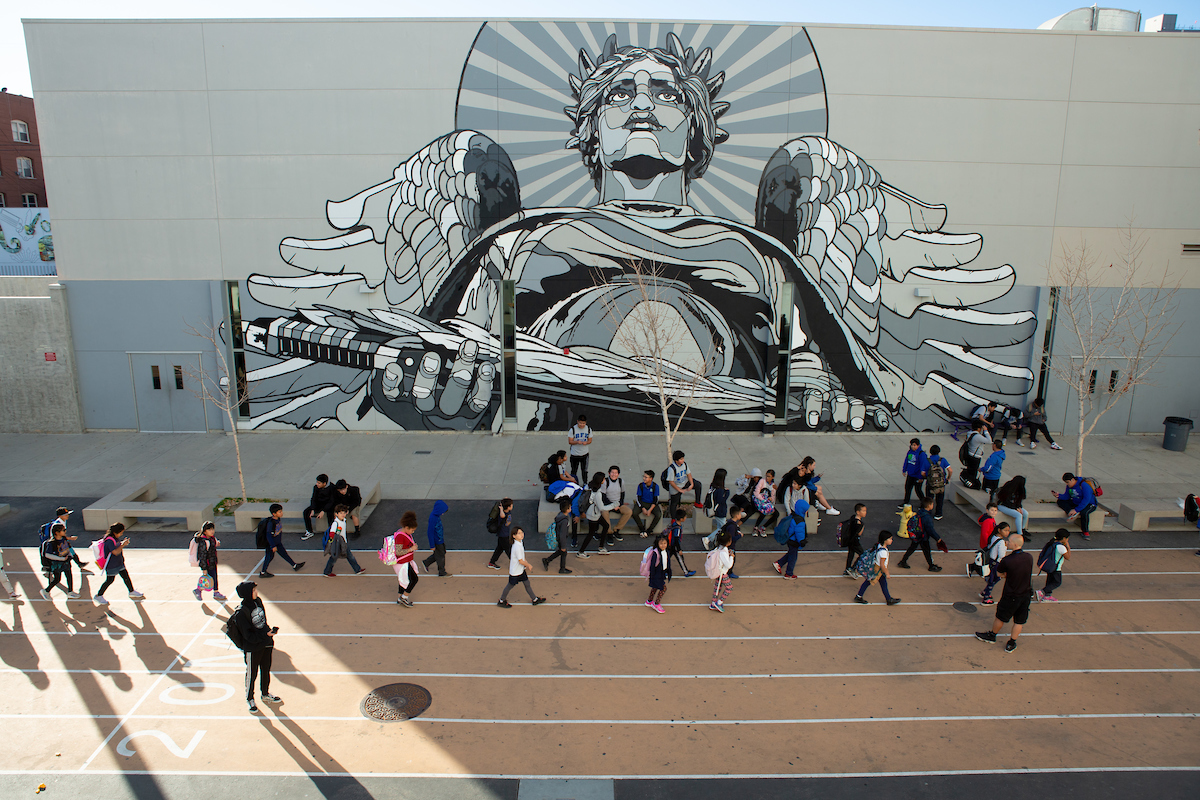
Summary
Supporting students to actively and critically participate in their own learning requires extensive infrastructure in schools that serve historically nondominant students. As this report documents, students from these backgrounds tend to have fewer opportunities than their more privileged peers to express and draw from their diverse voices and assets in schools. Disrupting this legacy of marginalization requires attention to multiple levels of the educational ecology. In this report, researchers and practitioners examine the ecology of a community school committed to student agency and democratic participation. As a reform strategy, community schools are anchored by collaborative structures that create roles and processes for students to participate meaningfully in knowledge creation and governance at schools. We share our experience creating these structures in order to help other educators and policymakers design and implement organizational and pedagogical practices that position students as key partners in learning and governance in schools.
The UCLA Community School is a TK-12 university-assisted community school built through a pilot school agreement between LAUSD, UTLA, and UCLA with localized governance structures allowing for a high degree of school-level autonomies. In our research, we found that the following aspects of the school ecology played important roles in supporting student agency at the school:
- School Context: The array of social, cultural, linguistic, and political assets of school stakeholders, including the teachers, students, community members, and researchers served as building blocks for practices that were designed and implemented to support student agency in school governance and content area learning.
- Organization: The school was organized through its equity-focused mission, vision, and community schooling practices that facilitated opportunities for stakeholder collaboration, teacher autonomy in professional learning and curriculum design, and student asset-based pedagogy. University researchers served as partners in each of these processes.
- Leadership: School leadership legitimized the commitment to student agency in school governance and content area learning.
- Pedagogical Practices: The pedagogical practices highlighted in this report stemmed, in part, from the organizational and leadership practices of the school. They built on the cultural and linguistic assets of the students, democratized the learning process, and engaged students in open-ended inquiry that were relevant beyond traditional school boundaries.
- Student Outcomes: Student participation in shaping school practices and classroom inquiry facilitated their own identity development, activism, and academic engagement.
Based on these findings, we recommend that district leaders work to provide schools with the autonomy to shape their educational practices through community partnerships. In response, schools should find meaningful roles for students, leveraging their assets, to shape school practices and classroom learning.
Introduction
This report highlights how support for student agency at the UCLA Community School was distributed across district policy, school organization, instructional practices, stakeholder collaborations, attention to student identity development, and connections to the broader school community. These include the district-level pilot school initiatives negotiated with the teachers union, the organizational commitments and structures of the UCLA Community School, the work of departments, individual educators, and researchers to create educational practices for students to engage in learning that builds on their assets and interests, and the students themselves, who brought to bear an array of assets and aspirations to engage in meaningful learning and impact the broader school community. By reporting on these education processes and outcomes at the UCLA Community School, this report seeks to help educators and policymakers design and implement organizational and pedagogical practices that support student agency in school governance and learning as a way to promote educational equity.
For this report, student agency in schools is broadly defined as opportunities for students to shape their own educational experiences, particularly through school governance and academic learning. Such opportunities have been found to facilitate the refinement and expansion of instructional practices (e.g. Cook-Sather, 2007; González, Moll, & Amanti, 2006), students’ content area engagement and learning (e.g. Barton & Tan, 2010), and students’ development in a number of important non-academic competencies (e.g. Kirshner, 2008). Equally, if not more importantly, student agency serves as a building block for schools envisioned as facilitators of democracy and social justice (Ginwright, Cammorta & Noguera, 2005). From this perspective, the historical exclusion of nondominant students from participating in the construction of their own educational life is an important issue of equity in education (Delpit, 2006; Ginwright et al., 2005; Ladson-Billings, 2006).
The section, What Do We Know About Student Agency in Education?, highlights some pertinent perspectives on student agency from the research literature, including theories on student agency, what supporting student agency looks like across multiple schooling contexts, and the constraints and dilemmas in education related to supporting student agency. The following section, Infrastructures for Student Agency at the UCLA Community School, highlights how the theories on student agency in education were embodied, leveraged, and/or designed at the UCLA Community School to form an integrated infrastructure that empower students in school governance and learning. Aspects of the school’s political history, organization, and collaborative practices are discussed. In the section, Practices that Bring Student Agency to Life, teachers and researchers highlight classroom practices and collaborative work that align with the school’s vision. The section, Student Perspectives, examines how students experience the various school efforts centered on their agency. Finally, based on the successes and challenges from the UCLA Community School’s efforts to support student agency, key takeaways, recommendations, and tools for organizing similar efforts are shared.
Background of this Report
The UCLA Center for Community Schooling is committed to advancing public scholarship on a broad range of issues. This report is one in a series that brings together researchers and practitioners as co-authors to share research, practical experiences, and policy resources to inform the work of community schools. This report was primarily compiled by Ung-Sang Lee, who has engaged in a number of research efforts at the UCLA Community School centered on student agency. The combined findings from these studies and further conversations with school stakeholders inform this report. For his dissertation study (Lee, 2019), Lee formed a collaborative design group with a group of students to develop school technology practices that were more aligned with student assets and interests. He has also engaged in student interviews that examined students’ views on what kind of school practices and processes supported their participation in the school’s social justice mission.
What Do We Know About Student Agency in Education?
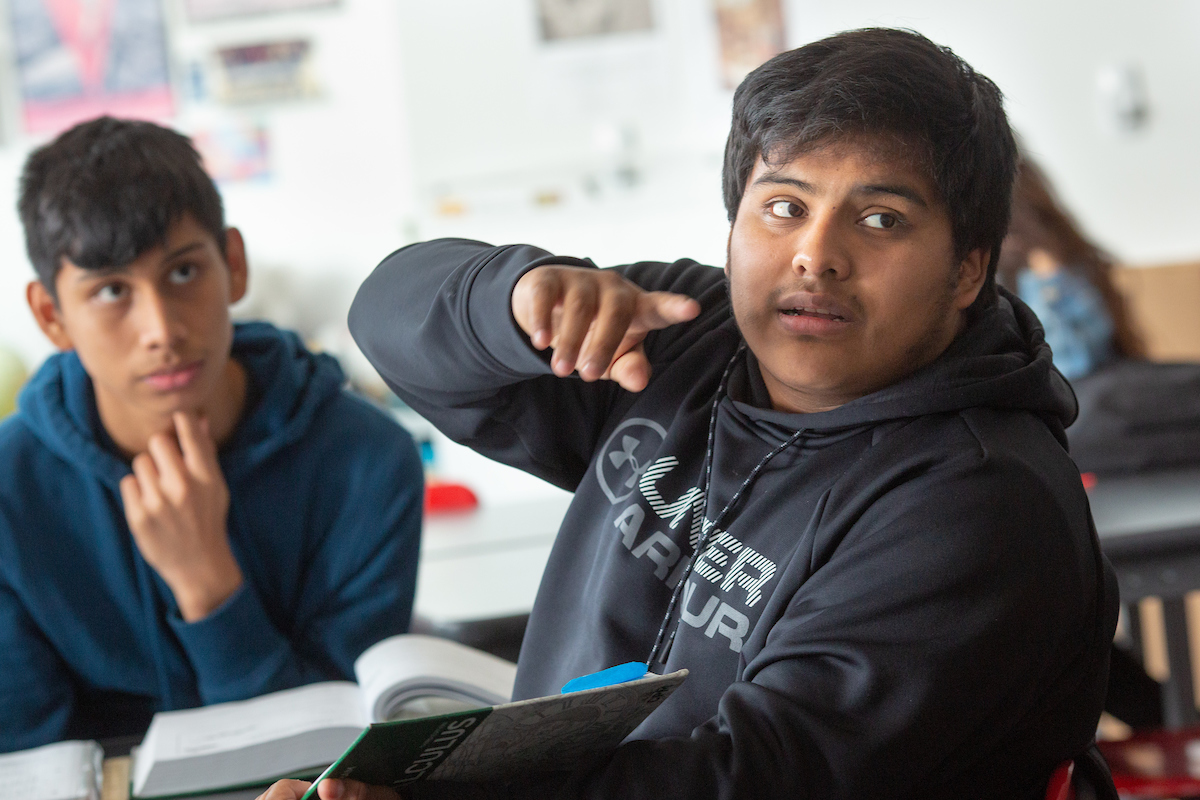
This section summarizes key takeaways from the literature regarding student agency in education to situate the work at the UCLA Community School within broader discussions in education. These include literature on theories of student agency, the intersection of student agency in schools and issues of equity, documented practices that support student agency in schools, and their outcomes.
Supporting student agency requires attention to multiple levels of the educational ecology.
Some theorists view student agency as an individualized process in which students choose certain actions, behaviors, and identities (e.g. Larson & Angus, 2011). On the other hand, those with more structural perspectives view agency as opportunities constructed of broader social contexts (Ahearn, 2001). However, much of the discussions pertaining to student agency in the field of education take an integrated approach between these two perspectives. Sociocultural theories of student agency view student agency as a process in which student actions, decision-making, and identity development are in dynamic conversation with the social contexts they are situated in (e.g. Goodman & Eren, 2013; Kirshner, 2008; Rodriguez, 2013). These educational contexts are shaped by educators, students, the immediate community, as well as broader sociological and political contexts (Apple, 1979). Students also intentionally and unintentionally transform the spaces they occupy and facilitate their own identity development, creating dynamic processes between sociocultural contexts and student agency. This necessitates attention to multiple levels of the educational ecology when supporting student agency, including broader sociological contexts, school organization, and individual student identity.
Historically nondominant students tend to have fewer opportunities to express their agency in schools.
One way in which student agency in schools intersects with broader social contexts is the way in which student agency is encouraged along demographic lines. A number of researchers have pointed to the exclusion of historically nondominant students from educational processes that privilege the assets and perspectives of historically nondominant students (Delpit, 2006; Ginwright et al., 2005; Ladson-Billings, 2006). Policy-level pressures such as high-stakes testing further privilege the traditional power relations between educators, students, and their communities (Au, 2008). Solorzano & Yosso (2001) point to deficit perspectives of these students and their families as a driver of such exclusion. In response, many point to the need to facilitate the meaningful participation of students and their communities in shaping their own educational spaces as a pathway to reversing the effects of historical divestments from nondominant communities (e.g. Bang & Vossoughi, 2016).
Community schooling models are committed to student agency.
While there is an abundance of literature that examines how direct partnerships and asset-based work with students can support their agentic participation in shaping their educational pathways, the research literature is relatively thin on what kind of school organizations may be conducive in supporting student agency. As such, educators may find it difficult to find direct resources that can guide the processes and practices that support student agency at the school organizational level. Community schooling and related models of democratic, collaborative leadership and practices in schools (Bryk, 1999; Oakes, Maier & Daniel, 2017) offer valuable guideposts in what kind of school organizations might support student agency. Collaborative leadership, one of the four pillars of community schooling as identified by Oakes and colleagues (2017), have been found to facilitate school organizational learning. Collaborative leadership has also been found to improve student academic engagement and outcomes (Heck & Hallinger, 2010). However, the literature also suggests that such gains are contingent on local contexts and the effective implementation of collaborative leadership structures, and at times can lead to undesirable outcomes (Sanders, 2015). The literature currently lacks specific insights into what kind of organizational structures and practices support student participation in these collaborative processes. Given the abundance of literature that point to the affordances of educational practices that position students as active agents for improvement, innovation, and learning in schools, more work needs to be done to articulate a holistic view of schools’ infrastructures that support student agency.
Educational practices that build on student assets to support their agency have shown promising outcomes for equity, school improvement, and student learning.
There is a relative lack of literature on how aspects of school organization support student agency. However, this does not reflect the benefits of supporting student agency through asset-based perspectives of students. Educational practices that seek to remediate traditional power dynamics between nondominant students and schools, such as those informed by culturally-relevant pedagogy (Ladson-Billings, 1995), funds of knowledge (González et al., 2006), and critical pedagogy (Cammarota & Fine, 2010), are inherently tied to student agency, as they each view student agency as an end in itself and a necessary condition for social justice (Rodriguez, 2013). While they each stem from theoretical roots that both intersect and diverge, these approaches have collectively demonstrated that when educational practices are designed in ways that honor student assets, students engage strongly with content area learning, identity development, and school leadership (e.g. Barton & Tan, 2010; Lee, 2019).
A number of constraints and dilemmas in supporting student agency require local attention.
There are a number of constraints and dilemmas associated with supporting student agency in schools (e.g. Goodman & Eren, 2013). These constraints and dilemmas are distributed across multiple aspects of schooling. Rios-Aguilar and her colleagues (2011) ask important equity-oriented questions directed at efforts to support student agency in schools. Given the political and sociological climates in which the assets of nondominant students are undervalued or in many cases, attacked, these scholars ask how local school efforts to privilege these assets might lead to authentic student agency and equity. As an example, Vissoughi and colleagues (2016) point to the popular discourses on maker movements and the use of digital technologies within them as spaces where ideas such as student agency are powered and contested. Where mostly white, middle-class youth who participate in maker spaces are portrayed as ingenious inventors (Vossoughi, Hooper & Escudé, 2016), nondominant students such as those who reprogrammed school-issued tablet computers to access online resources for homework (Blume, 2015) may risk being labeled as deviant “hackers” while engaging in similar activities. Then, it is important that efforts to support student agency pay attention to macro-level politics and their local instantiations (e.g. Apple, 2011; Rodriguez, 2013; Zipin & Reid, 2008).
Infrastructures for Student Agency at the UCLA Community School
The social, historical, and political context of the Community School, its school organization, collaborative practices, and instructional practices are discussed in this section to provide readers with a birds-eye view of how these elements interact to create a schooling experience for students that build their agency.
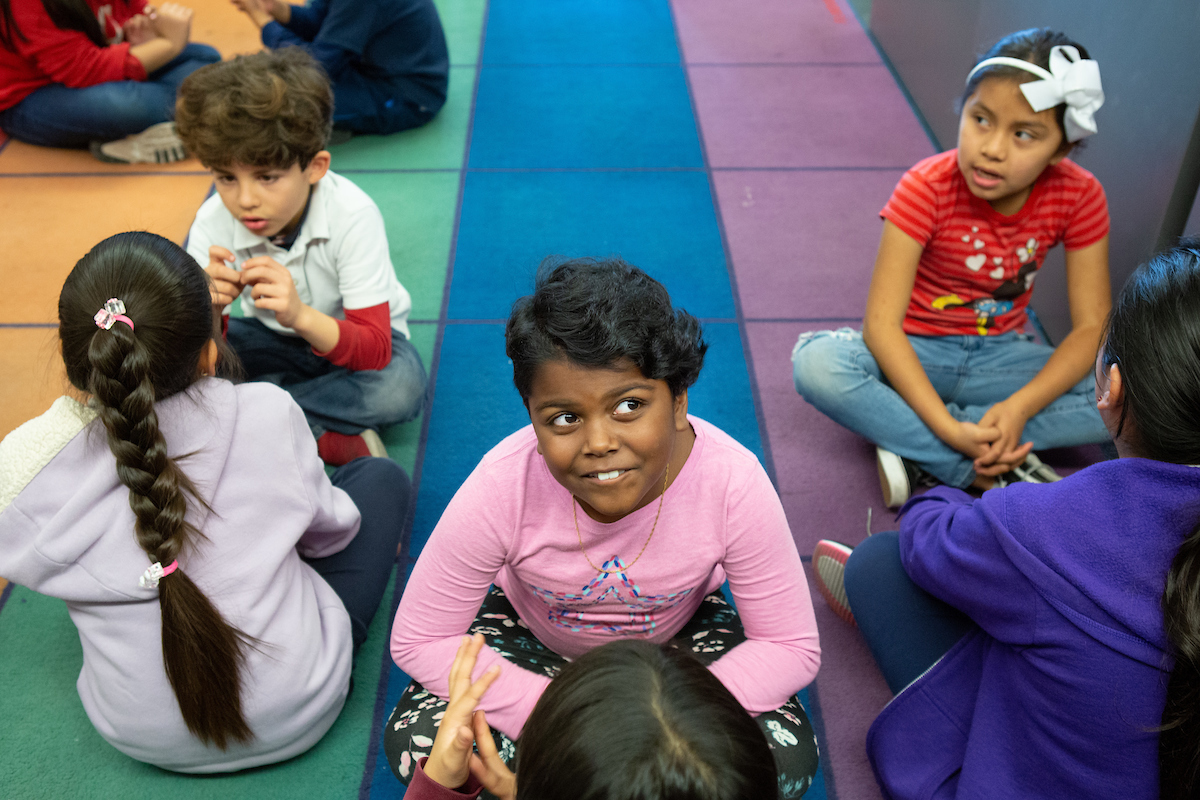
School Context
The UCLA Community School is a TK-12 university-assisted community school (Harkavy & Hatley, 2009) that was built in response to a number of political, social, and educational drivers. The primary policy context that drove the formation of the school was a new pilot school agreement between LAUSD, UTLA, and the local community of Pico Union (Martinez & Quartz, 2012). The pilot school framework facilitated the creation of ten pilot schools that were governed by localized governance structures with a unique degree of school-level autonomy in hiring, curriculum, professional development, and other areas. As a part of this policy, the UCLA Community School was established within a larger campus of six pilot schools that were built in central Los Angeles to serve neighborhood students. The location was chosen due to the historical lack of neighborhood schools in the area, which meant students in the neighborhood had no clear K-12 pathways and often traveled to public schools in other parts of the city. The pilot schools agreement was also seen as a way to respond to the increasing number of charter schools and the advantages of more autonomous governance structures.
The central Los Angeles neighborhood in which the school is located has seen a high level of demographic shift throughout its history, building the social, cultural, and linguistic assets embodied in the school community. In recent years, the neighborhood has had a strong presence of people with Mexican, Korean, Salvadorian, Guatemalan, and Filipino backgrounds. The student demographics at the school reflect the broader demographics of the neighborhood where approximately 80% are Latinx, 15% Asian, and 2% African American. Approximately 35% of the students are classified as English Language Learners. 92% of the students are considered “socioeconomically disadvantaged”. The assets of the teaching staff are considerable as well, given 44% are Latinx, 28% are Asian, and 6% are African American. 85% are bilingual, and 9% are trilingual. The neighborhood, however, is also experiencing a period of gentrification at the time of this writing, with visible signs of resident displacement and reconstruction.
Organization
The school, leveraging its pilot school autonomies, has set up a number of organizational practices that directly and indirectly support student agency. The most fundamental characteristic of the school is its commitment to social justice. From its inception, the teachers and administrators at the school viewed social justice as its core educational mission, and the school’s 4 Core Competencies (4CCs) has been an organizing framework for this social justice mission. Consequently, discussions on social justice and the 4CCs permeate teacher meetings, professional development, and classroom instruction. Specifically, administrators, teachers, researchers and students are often heard discussing how these goals will be understood and operationalized local educational practices. Students are expected to graduate with the following skills and knowledge as defined by the 4CCs:
- Self-directed, passionate learners
- Masters of content knowledge and skills
- Biliterate, bilingual, and multicultural
- Active and critical participants in society
The broad language of the 4CCs allow for educators, students, and other stakeholders to have a level of autonomy around how they are implemented in the school and classrooms. However, this has led to some challenges developing educational practices that are aligned in their assumptions and presumed outcomes (Quartz et al., 2014).
Another core framework that drives the educational work at the school is its alignment with principles of community schooling (Oakes et al., 2017). Although not all schools that consider themselves “community schools” may strive to operationalize all of these principles, or focus on them evenly, community schools are generally organized around the following four principles (Oakes, 2017, P.7):
- Integrated student supports: A network of coordinated social and health services.
- Expanded learning time and opportunities: Learning that crosses traditional classroom boundaries through after school hours and out-of-school connections.
- Active parent and community engagement: Empowered roles in the school for parent and community partners.
- Collaborative leadership and practices: Leadership and ownership for school initiatives are distributed across school stakeholders.
The commitment to community schooling guides a number of school organizational practices that create conditions for collaboration across school stakeholders. Stakeholders form groups of various configurations to address specific educational goals and problems of practice. These include summer Research and Development (R&D) projects where summer funding is made available to teachers working collaboratively to engage in interest-driven research and design projects that can enhance their practice. Research-practice partnerships (RPPs) are also important aspects of this culture, where educators and other school stakeholders partner with university researchers to investigate issues that are important to practice and research. A formal Research and Accountability Committee (R&A committee) vets and oversees these RPPs. Furthermore, instructional time dedicated to interest-driven inquiry (“seminars”) and community building (“advisory”) are made available for teachers and students to engage in learning that do not fit traditional content-area boundaries.
The Role of Research
Research-practice partnerships (Coburn & Penuel, 2016) play an important role in supporting the efforts at the school to design and implement pedagogical practices that align with the school’s social justice mission. These partnerships aim to form collaborative communities that advance the pedagogical practices at the school, advance research methodologies and findings that are rooted in the needs of educators, and develop generalizable knowledge to inform the work of educators globally. Researchers from UCLA and stakeholders from the Community School partner in small inquiry groups to identify areas of need and problems of practice, collaboratively brainstorm solutions that are rooted in theory and practitioner knowledge, and continuously refine the designed solutions through implementation and data collection.
Leadership
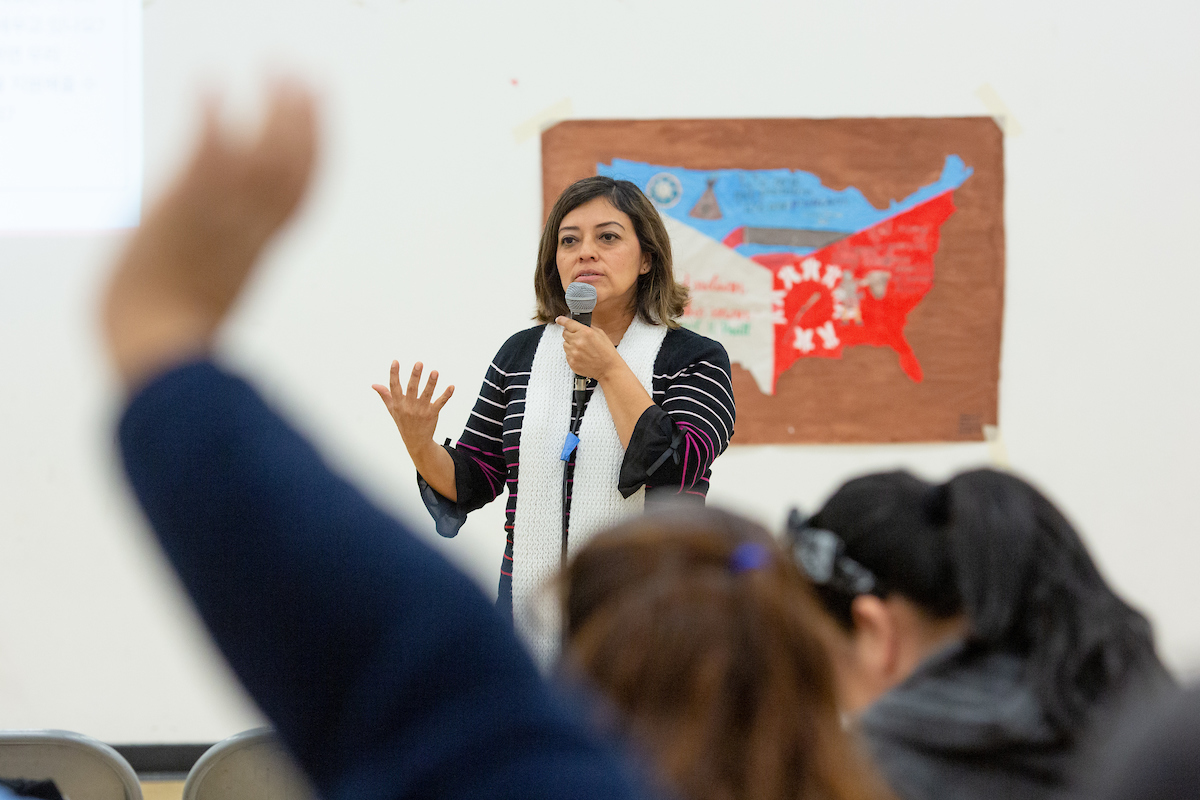
The leadership of the administrative team plays a critical role in legitimizing the school’s commitment to student agency. Ms. Leyda Garcia, the school’s principal of 8 years, views supporting student agency at the school as a critical process of the growth of students as well as the school. In the following excerpt, she describes her perspectives on the affordances of supporting student agency as a school leader, how she navigates some of the tensions in supporting student agency as a school leader, and her vision for the school moving forward. Together, she points to a vision of the school that is always evolving with its community:
As a formal leader, I have the privilege of being in a lot of spaces, interacting with students and teachers for a variety of reasons. I get a birds eye view of the macro to the micro. I get to be there for the critical moments and activate the systems in the school, and I get to see the ideas and projects when they come from the parents, students. This allows me to support these people and ideas by making the spaces for them. Then, everybody makes them better together. I am there to open the door, and they take it all and give them lives of their own. I see a lot of what I do as building democratic structures and processes. Having explicit structures and processes allows us to look back at what we are doing and make sure that we remember the things we do well and work on the areas of improvement. Often, administrators will not be the ones to write the plan, but we can help figure out what processes to use. For us, we always connect back to the mission and vision of the school like the 4CCs. Every project is always connected to the overarching principles and beliefs of the school.
In addition to broad stakeholders, I try to make available spaces for students that helps them structure their agency at school. First, students are exposed to the tools and ideas that allow them to reflect on their community and their learning within it. Through self-reflection, we get to figure out who we are and who we are trying to be. The more I work with students, I realize that every human being is driven by their sense of self and sense of purpose. Students need to be given the autonomy to make their own choices and contribute to shaping their educational space. When we, as educators, make assumptions about what the students want or need, we are often wrong. Of course, we care about what students are “supposed” to learn such as the standards and our school level learner outcomes such as the 4CCs, but these things are not mutually exclusive. We always have to interrogate what we do as a school, and students need to be part of that process. Ultimately, student agency is about students building community, knowing their roles within them, and being attentive to the learning of others. They go hand-in-hand.
There is a vulnerability as a leader when you support the agency of others. You have to make yourself vulnerable and open, and the more human you are, the easier you make it for everyone else. That means celebrating the things that go well, and owning up when things go awry. You have to own up to your mistakes and have a problem-solving orientation. We want all of our ideas to flourish and no one wants to hear their ideas need improvement, but there are always dimensions that have to be negotiated, and if I want to be heard, I need to be ready to listen too.
Practices that Bring Student Agency to Life
The school’s commitment to social justice and the frameworks that guide such work include the 4CCs and the organizational practices that help school stakeholders learn and design continuously towards its vision. This creates opportunities to develop pedagogical practices that center student agency. While these pedagogical practices are varied in their settings and immediate outputs, they share:
- a recognition of the cultural and social assets of students and that of the community as meaningful assets for learning and social justice;
- the democratization of knowledge by challenging traditional hierarchies between educators, students, and the surrounding communities;
- collaborative, open-ended inquiry processes with relevance beyond school boundaries.
At the UCLA Community School, pedagogical practices that share these characteristics are visible across grade levels and subject areas. Typically, teachers take the lead in designing these practices using existing organizational practices such as the aforementioned summer R&D funding and RPPs. The following section provides a deeper look into some of these pedagogical practices.
This section highlights the work of three teachers and the lead author to make visible the diverse array of educational practices that were developed at the school site to support student agency. Each case highlights the ways in which the school’s organizational structure, vision, and culture created a foundation for practices that support student agency. Through their own voice, three teachers and one researcher who were core drivers of these efforts describe the principles and motivation behind their work, how the work has progressed, and advice for other educators aiming to implement similar practices. Together, they point to the shared features of supporting student agency at the UCLA Community School, including the recognition of student assets, learning communities that are responsive to the members’ goals, and relevance beyond the school boundaries.
MISA Projects – Mr. Pedro De Leon (Chemistry)
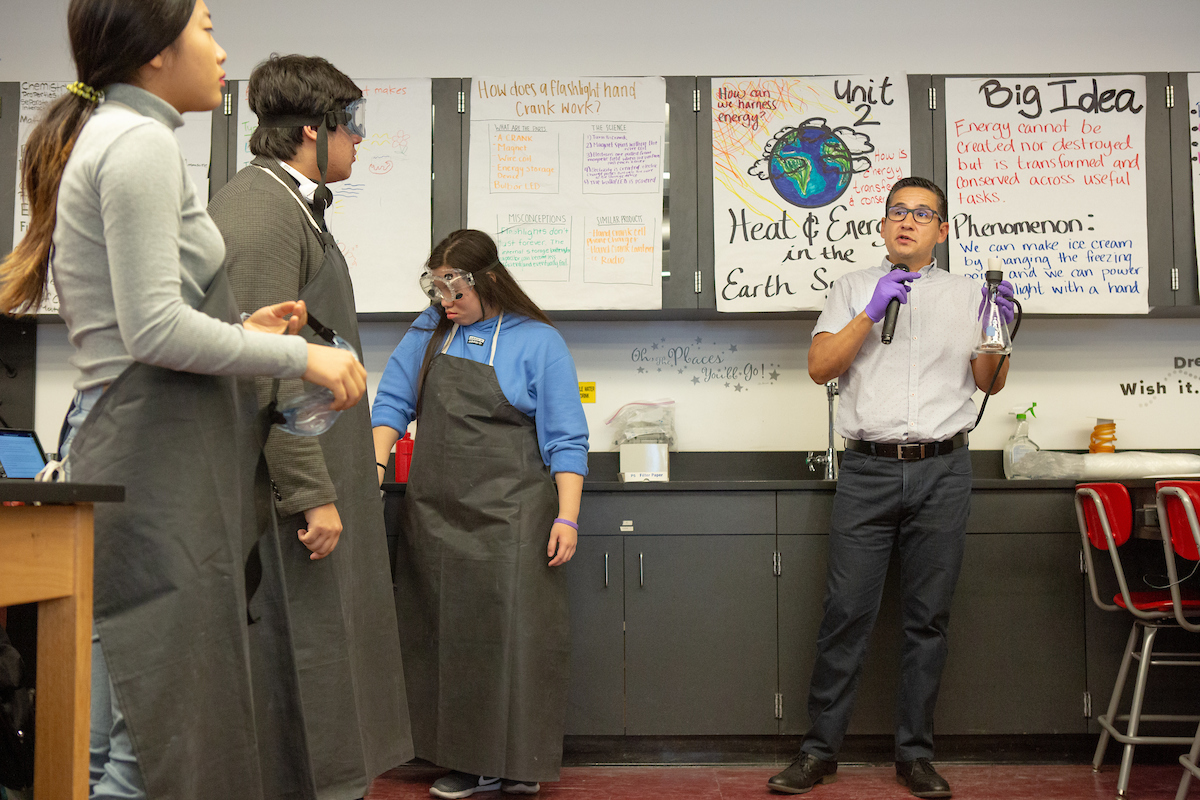
Mr. De Leon, a high school chemistry teacher with over 15 years of experience, was part of a group of teachers who developed interdisciplinary projects aimed at creating opportunities for students to engage in community-based research. With a group of colleagues and university researchers, he developed a Multicultural and Interdisciplinary Student Agency Project (MISA Project) where students investigated the link between the economics and the science of climate change through community-based research.
The MISA Projects began with teachers and administrators collectively asking how we can teach effectively in the subject areas in ways that were multicultural and social justice-oriented. We theorized that if we can connect the content areas to students’ cultural assets, they were more likely to engage in their learning. We also realized that if we wanted to advance our social justice mission, as articulated through the 4CCs, we had to make our teaching interdisciplinary. It was not possible to help students become critical participants in society if they did not have opportunities to cross disciplinary and school boundaries. This meant that we had to be intentional about collaborating with our colleagues to develop interdisciplinary curriculum, and we decided to implement our multicultural, interdisciplinary projects together..
We collaborated with UCLA researchers and developed a rubric to guide our interdisciplinary work focused on students, a) being a community builder, b) being a perceptive partner, c) being a mindful wordsmith, and d) being a critical thinker. For example, as a chemistry teacher, I use climate change as a hook to connect the science content with what they learned about the industrial revolution in their history class, thinking about the economic reasons that led to the overproduction of CO2. Moving forward, we want to pay more attention to student identity development, asking how, for example, we can help students identify as scientists and researchers.
The process helped us develop a deeper understanding of ways to operationalize the school vision (4CCs). It made the school vision a breathing document that is always evolving. We still have some challenges, such as trying to figure out a good way to measure our, and our students’ progress, as well as helping students who are unaccustomed to this learning culture to become familiar with our methods. But I think community schools have an advantage over others in developing this kind of work because the teachers are committed to similar goals, which is my biggest advice for others wanting to implement projects like this. You and your colleagues need a clear vision of where you want to go, and how you want to take on this kind of project. Students should be part of this process too. Another piece of advice is to be flexible about your teaching. It is very nontraditional. If you have a huge habit of trying to finish what you’re “supposed’ to finish, you are not going to be able to do it. If you want students to take agency, there needs to be space for it. There needs to be space to evolve the learning process.
E-Portfolios – Mr. Robert Ly (Math)
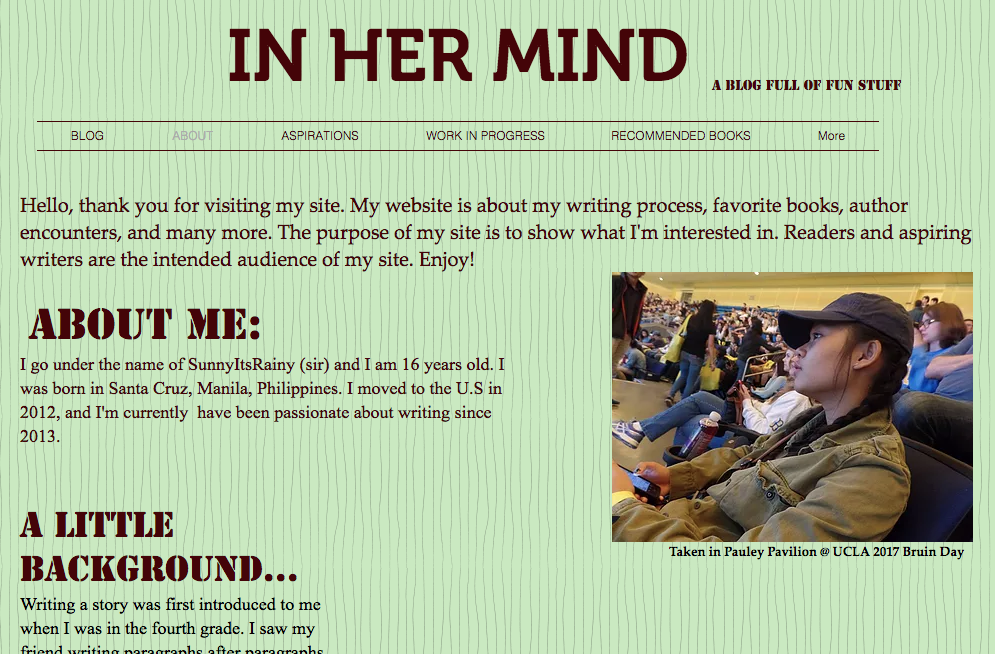
Mr. Ly organized a seminar class in partnership with UCLA researchers and students to co-design and prototype student e-portfolios. In his seminar, students developed personal websites that highlighted their personal narratives, cultural assets, and out-of-school interests. Students in this class played critical roles in the initial scaling of these e-portfolios at the school, and shared their insights in undergraduate lectures, UCLA faculty meetings, and teacher professional development sessions. The students in this class also became mentors and facilitators during grade level-wide implementation of the e-portfolios.
We developed an e-portfolio system, where students can track their growth over time by showing their work, their passions, and who they were from middle school through high school. We wanted something that showed their identity, values, and beliefs over time so that teachers and students themselves can see their own growth. We felt that we needed better ways to get to know who the students really were beyond their academics. Although you get to know your students quite well as a teacher in a small community school, with the e-portfolios, the hope was to get to know them even more. The things you don’t learn in a classroom, such as what their likes are, what they see as their own strength, and what their goals are. For me as a teacher, the goal is not just to teach content, but to prepare our students for life after high school. We thought the portfolio would be a way for us to see how the students’ perspectives have changed over time, so that we can see if we have really done our job. Did we see this student grow into their own identity? Did we see this person grow academically? Did we see this person prepared for life outside of high school? I think in larger schools this would be especially important. The growth of students will really surprise teachers when they have a chance to get to know their students more deeply.
We are still trying to figure out how to implement the e-portfolio system we designed across the school. We developed a design for the e-portfolio and plan for school-wide implementation, but we have had to go back to the drawing board a few times for a number of reasons. Teachers are realizing that it is a lot of work, so we are beginning to see intentional planning to make the implementation as sustainable as possible. If we build a solid foundation, it will get easier to implement over time, but agreeing on what that foundation will look like is the hard part. For example, we need to figure out how we want to leverage the school’s 4CCs to frame the student contributions to their e-portfolios. Students sometimes only see the 4CCs as an academic framework, and have trouble identifying assets they possess that fit into this framework beyond academics. We have to find a way to help students realize that all that they do beyond academics are important parts of their growth in the 4CCs.
It is important that students and parents are part of the planning process. Their voices need to be at the table. Parents will find the e-portfolios particularly eye-opening. When I used to do senior graduation presentations at my old school, parents used to be in tears learning about their child’s passions, identity, and growth. They used to say they never saw that side of their children. So they need to be partners in developing something like an e-portfolio. It is also important for the school to put concrete structures in place for implementation. Having clear ideas of where, when, and who will be supporting students in developing their e-portfolios will be critical, and in order to do so, teachers will need dedicated planning time.
AP Seminar and Research – Dr. Beth Trinchero (AP Seminar and Research; English)
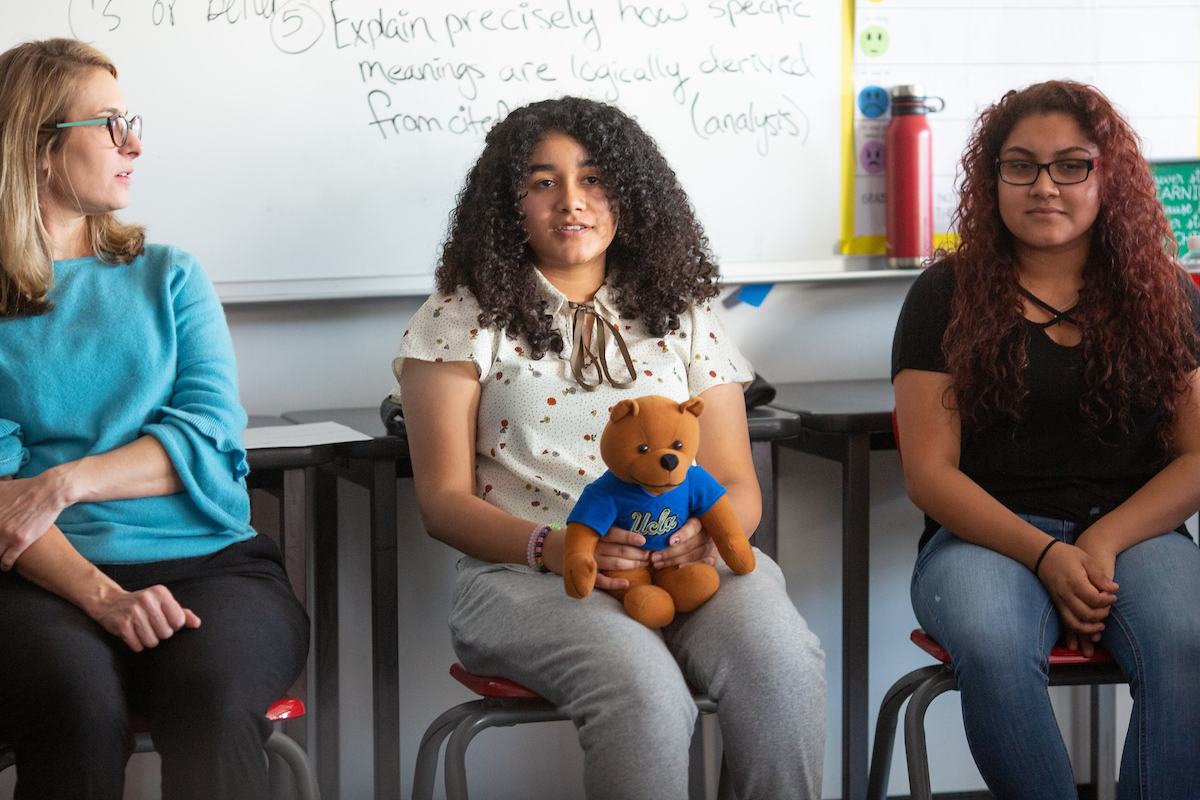
Dr. Trinchero is a founding teacher of the UCLA Community School who now teaches the AP Seminar and AP Research series where students engage in self-directed research projects that are relevant to their communities. In the courses, the students learn to conceptualize research projects with direct local impact, develop appropriate data collection and analysis processes, and present their findings to wide audiences. More recently, Dr. Trinchero has partnered with UCLA’s Center for Community Learning to pair students in her classes with UCLA undergraduate students to build collaborative learning opportunities.
In AP Research, students design an original inquiry research project, which they carry out over the course of one year. As part of the school’s commitment to community based research, AP Research partners with a UCLA undergraduate education research course and AP Research students are matched with UCLA undergraduate expert advisors, who mentor them during their research project, presentation, and oral defense. Students align their research projects to the school’s 4 Core Competencies and students identify how their research will benefit the school and surrounding community. Students share findings with different stakeholders in the community, including faculty, support staff, and other students. The course fits into a broader goal of college going, as students receive college credit if they pass the course. Students can additionally receive recognition, such as the AP Capstone certificate or diploma based on their success in this course, the AP Capstone program, and other AP courses.
The AP Research course is a space that relies on student’s curiosity, independence, and interests. Among the challenges have been providing adequate, one-on-one time to support all students in their inquiry projects. This semester, with the support of UCLA undergraduates, that challenge is being somewhat mitigated. Additional challenges are familiar to researchers at all levels, including securing enough participants in a timely fashion, completing data collection on a school-based schedule, and also analyzing the wealth of data gathered. Students also struggle with the independence offered by the course, as it is very self-directed and open in terms of work product. However, the AP Capstone program is extremely rewarding as an educator, and I am grateful that I have had the opportunity to teach each of the two courses. In particular, AP Research is a novel experience as an educator, for it requires that I have more of a coach-like mentality, asking guiding questions rather than providing answers to students. I believe that educators at any level would enjoy and appreciate incorporating research projects, whether small or large scale, that are student-developed and student-driven. Finding and building networks of support for students doing research is important, and will add to the success that educators and their students experience.
I hope to continue to build upon the partnership started this semester. Additionally, this year the AP Capstone program opened to 10th grade students, who will hopefully pursue AP Research in the 11th grade. By having this experience in 11th grade, students have the opportunity to include their experiences on college applications and to be mentors to incoming students in 12th grade. Creating a network of support for AP Research students, whether through UCLA undergraduate students or peer mentors, continues to be my hope and vision for the program.
Co-Designing School Technology Practices with Students – Dr. Ung-Sang Lee (UCLA)
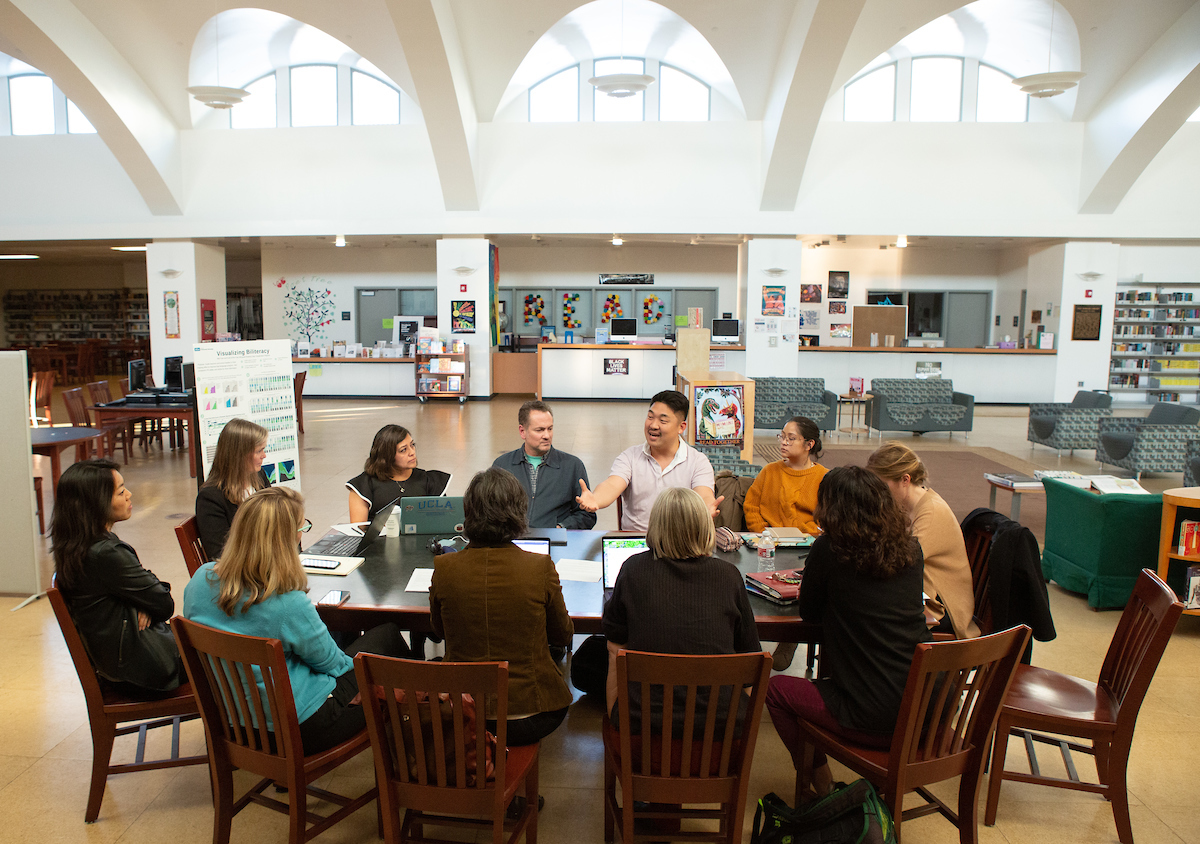
Dr. Lee facilitated an RPP between the 2014-2018 school years with an aim to design technology practices at the school through student agency and assets. Through the study, university researchers, students, and educators collaborated to design and implement a number of technology practices with an emphasis on privileging the voice and needs of students, including a highschool e-portfolio system and an afterschool e-sports club. These designs were implemented locally and shared more broadly with an academic audience such as students in teacher preparation programs and researchers.
The district’s well-publicized struggles with a large purchase of iPads in 2013 underscored the need for greater local control and student empowerment in the way digital technologies were being introduced in schools. The Community School had begun articulating a local technology plan, including a five-year technology plan, the purchase of a learning management system, and investments in various new hardware. This in turn created an opportunity for me to investigate how student participation may benefit the design of school technology practices by developing a partnership with students to co-design technology practices for the school. I proposed a study to the school’s R&A committee, and along with a partner teacher, used the flexibility of advisory classes to meet her class on a weekly basis and conceptualize technology practices that met the needs and interests of students. As the partnership grew, we moved to after school and seminar time to advance the collaboration with students further. Consequently, the students and I, in conversation with teachers and administrators, co-designed technology practices that were rooted in the needs and assets of students, including an e-portfolio system, resources for college going, and an after school e-sports tournament. Furthermore, these innovations were shared widely with school and university audiences both for the purposes of implementing the innovations and knowledge sharing.
As a new partnership, we spent a lot of time articulating the group’s mission. This included conversations about the norms and practices of the partnership group, as well as the design principles that would inform our school technology practice. Responding to the students’ stated priorities, we organized our collaboration to allow for students to develop collaboration and presentation skills, while our designs focused on creating opportunities for the broader student body to have opportunities to use school technology to engage in, and make visible their holistic identity development. This led to the aforementioned innovations, such as the e-portfolio system and the e-sports tournament. By structuring the collaboration to meet the needs and interests of students, students were able to engage in the design partnership by building on their own aspirations, social networks, linguistic assets, and political orientations.
Moving forward, I would like to find more structured ways to develop sustained partnerships between administrators, teachers, and students. While the UCLA Community School already engages in a lot of work to remove some of the traditional barriers for youth-adult collaborations, and we worked to contribute to this work, there were still times when we struggled to align the goals of the students and teachers. Doing so will be hugely beneficial for the development of school practices as well as for the rigor of the research that is being conducted at the school. For others who are similarly working to partner with students to develop school practices, I would recommend developing explicit expectations within the school about how student voices will be integrated into the broader development of school practices. In addition, when partnerships with students are being formed, it is crucial to organize the partnership in ways that support student learning because collaborating with adults usually requires the students to develop new skills and competencies.
Student Perspectives
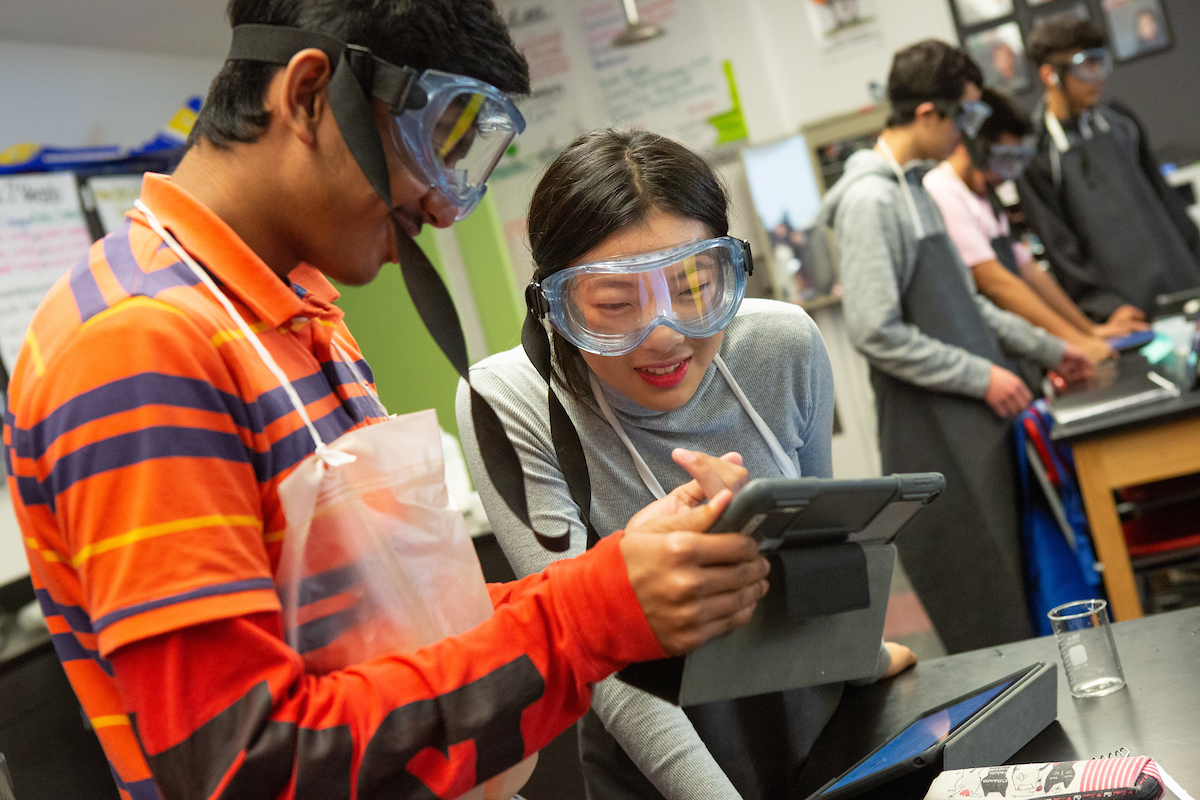
In a series of interviews conducted with UCLA Community School students about their experience at the school site, particularly around the 4CCs, students offered insights into how educators created a culture and practices that supported student agency. They discussed how the educators’ practices impacted their own engagement with schooling, including some critiques of the school practices.
A number of students discussed how the educators created ways to legitimize the students’ ways of knowing, and create a culture of mutual learning among students and teachers. One student explained:
Teachers are very interested in learning from us… Many people see teachers as like oh, this position of authority, they know everything. But all teachers, they’re very open about saying that I don’t know everything. You guys are going to teach me and then I can teach you.
Similarly, another student explained how traditional power dynamics between teachers and students are renegotiated to create a culture where failure is destigmatized and used as an opportunity for learning:
When teachers value students’ ideas and then say, “Wow great idea,” instead of saying something like, “No, that’s wrong.” They can say it because they’re a teacher. They (can) say, “That’s wrong. No, no, don’t even think. That’s stupid.” They can say it but they’re just like, “Interesting. Wow. Who else can add onto that idea?” That means they want to learn from … the different, diverse ideas. Even teachers want to grow in this place and want to … explore themselves
Consequently, a student suggested how such an approach by the educators allowed students to become legitimate partners in the creation of a broader school culture:
There’s a really friendly atmosphere that comes from the teachers and counselors that makes you…want to be a part of that culture…You don’t feel like pushing them away. They’re willing to accept you into their culture, they’re open to your music, dance, food, culture, religion. You feel accepted as a part of this culture.
When students became legitimate drivers of learning at the school, they were able to leverage their perspectives and assets to engage in learning with “passion”:
I think for them to let us go out of our … In a way it’s out of our comfort zone ’cause our comfort zone is like this is your direction and you’re going to do this. But…when you get out of our comfort zone which is like do whatever you want. You could choose any topic, your own views and you just present it. So I think in a way it’s like passion, the passion comes in.
Although students for the most part appreciated the school’s focus on social justice and its commitment to respecting student agency, a student critiqued the ways in which the strong encouragement by teachers for students to actively engage in their community can act as a sort of crutch for the students. The following quotation from a student interview captures such a sentiment:
Teachers do actively push students to connect with the real world, to use what they know in the world. But I just feel like students on their own are less willing and less capable of doing so, unless pushed by a teacher.
Furthermore, a student pointed to the risks of building a community that is so dedicated to social justice. This student suggested that when all the teachers and the students in a school are so politically progressive, they may become sheltered from contrasting ideas, stunting their own thinking or leaving them less prepared to advocate for their own perspectives. The student explained:
Sometimes it feels one-sided. If you go to some other school, it’s very European based. Here we of course learn about that, but sometimes it also feels like over liberal. I identify with all of the things they teach me, but then it would be nice to have a different side of it as well. I feel like I’m very sheltered, because I’m not exposed to a lot of ideas that clashes with mine
Ultimately, the underlying theme shared by most of the students who were asked about the school’s commitment to supporting student agency was that the efforts to value student perspectives and assets in the formation of educational practices built the foundations for students to engage in their own identity development, activism, and sense-making. As a student explained:
I think it is very important that students’ voices are out there in the world because we’re the next generation of change. Okay, you listen to the adults and what their concerns are, but you also should be listening to students, like, why we want this or what are the struggles that we’re having, so you can make a change.
Conclusions and Recommendations
The support for student agency at the UCLA Community School is distributed across multiple levels of the school ecology. The extent to which student agency is distributed across the school ecology also represents the extent to which each of these spaces are dedicated to learning and ongoing improvement. As such, all stakeholders who drive the work described in this report stated a commitment to expanding their practices in response to student interests, assets, needs, and voice. The school stakeholders continue to see areas where support for student agency can be improved. There is an eagerness at the school to address questions such as how to expand the network of stakeholders that support the work of students, how to vertically align instruction that supports student agency, and how to balance student agency with learning outcomes that are held as fundamental goals of the school. While these questions are still being grappled with, students see the commitment to student agency driving the instruction that connects their schooling to their assets.
School districts and policymakers should support school autonomies to shape the learning of educators and the students. These autonomies should be explicit components of school organizational strategies and labor contracts, especially in school models such as community schools that envision a collaborative relationship with community stakeholders. With such autonomies, schools are able to articulate a vision that meaningfully considers the role of students and their communities in the design of school practice. Reserving meaningful roles for students to shape school practices and learning within classrooms creates opportunities for the assets of historically nondominant students to be made visible, activated, and invested in. These practices create opportunities for students to develop skills and competencies such as research skills, presentation skills, and collaborative skills that further enhance their agency.
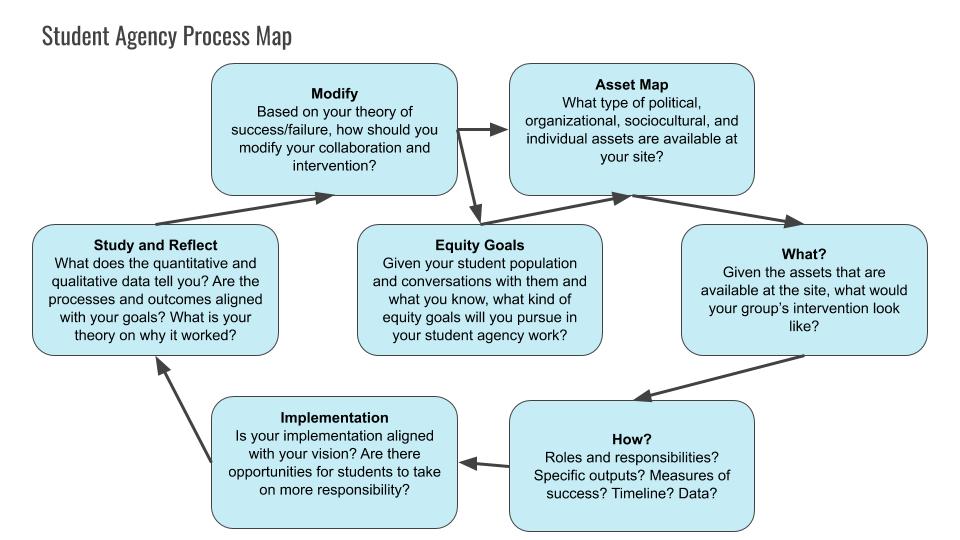
These aspirations need to be supplemented by concrete organizational practices that help teachers engage in their own inquiry and design, build a safe culture for experimentation, and flexibly adapt to emerging local knowledge. This report suggests that these are important pieces of infrastructures that allow student agency to thrive. As suggested Student Agency Process Map (above), these systems need to be built iteratively on an ongoing basis to respond to what is learned in the process. The pedagogical practices and educator efforts highlighted in this report point to the intentional, strategic work that underlie the supports for student agency. As such, these efforts must be supported through organizational practices, labor contracts, leadership, and research that puts trust in the hands of school educators and students.
Acknowledgements
This research was made possible through funding by the Stuart Foundation, the Ahmanson Foundation, and the University of California, Los Angeles. Photos by Allison Shelley for American Education: Images of Teachers and Students in Action
References
Ahearn, L. M. (2001). Language and agency. Annual review of anthropology, 30(1), 109-137.
Apple, M. W. (2011). Democratic education in neoliberal and neoconservative times. International Studies in Sociology of Education, 21(1), 21-31.
Au, W. W. (2008). Devising inequality: a Bernsteinian analysis of high‐stakes testing and social reproduction in education. British Journal of Sociology of Education, 29(6), 639-651.
Bang, M., & Vossoughi, S. (2016). Participatory design research and educational justice: Studying learning and relations within social change making.
Barton, A. C., & Tan, E. (2010). We be burnin’! Agency, identity, and science learning. The Journal of the Learning Sciences, 19(2), 187-229.
Blume, H. (2015). New report finds ongoing iPad and technology problems at LA Unified. LA Times. Retrieved September, 2, 2015.
Breuing, M. (2011). Problematizing critical pedagogy. The International Journal of Critical Pedagogy, 3(3).
Bryk, A. (1999). Charting Chicago school reform: Democratic localism as a lever for change. Routledge.
Cammarota, J., & Fine, M. (Eds.). (2010). Revolutionizing education: Youth participatory action research in motion. Routledge.
Coburn, C. E., & Penuel, W. R. (2016). Research–practice partnerships in education: Outcomes, dynamics, and open questions. Educational Researcher, 45(1), 48-54.
Cook-Sather, A. (2007). What would happen if we treated students as those with opinions that matter? The benefits to principals and teachers of supporting youth engagement in school. NASSP bulletin, 91(4), 343-362.
Cook-Sather, A. (2007). Resisting the impositional potential of student voice work: Lessons for liberatory educational research from poststructuralist feminist critiques of critical pedagogy. Discourse: studies in the cultural politics of education, 28(3), 389-403.
Delpit, L. (2006). Other people’s children: Cultural conflict in the classroom. The New Press.
Ladson-Billings, G. (1995). Toward a theory of culturally relevant pedagogy. American educational research journal, 32(3), 465-491.
Larson, R. W., & Angus, R. M. (2011). Adolescents’ development of skills for agency in youth programs: Learning to think strategically. Child Development, 82(1), 277-294.
Lee, U. S. A. (2019). Infrastructuring for Participatory Design: Supporting Student Agency in School Technology Use (Doctoral dissertation, UCLA).
Longwell-Grice, H., & McIntyre, E. (2006). Addressing Goals of School and Community: Lessons from a Family Literacy Program. School Community Journal, 16(2), 115-132.
Ginwright, S., Cammarota, J., & Noguera, P. (2005). Youth, social justice, and communities: Toward a theory of urban youth policy. Social justice, 32(3 (101), 24-40.
González, N., Moll, L. C., & Amanti, C. (Eds.). (2006). Funds of knowledge: Theorizing practices in households, communities, and classrooms. Routledge.
Goodman, J. F., & Eren, N. S. (2013). Student agency: Success, failure, and lessons learned. Ethics and Education, 8(2), 123-139.
Harris, A. (2009). Distributed leadership: What we know. In Distributed leadership (pp. 11-21). Springer, Dordrecht.
Heck, R. H., & Hallinger, P. (2010). Testing a longitudinal model of distributed leadership effects on school improvement. The leadership quarterly, 21(5), 867-885.
Hempel-Jorgensen, A. (2015). Learner agency and social justice: what can creative pedagogy contribute to socially just pedagogies?. Pedagogy, Culture & Society, 23(4), 531-554.
Kirshner, B. (2008). Guided participation in three youth activism organizations: Facilitation, apprenticeship, and joint work. The Journal of the Learning Sciences, 17(1), 60-101.
Martinez, R. & Quartz, K.H. (2012). Zoned for change: A historical case study of the Belmont Zone of Choice. Teachers College Record, 114(10).
Mitra, D. L. (2004). The significance of students: can increasing” student voice” in schools lead to gains in youth development?. Teachers College Record, 106, 651-688.
Oakes, J., Maier, A., & Daniel, J. (2017). Community Schools: An Evidence-Based Strategy for Equitable School Improvement. National Education Policy Center.
Ozer, E. J., Ritterman, M. L., & Wanis, M. G. (2010). Participatory action research (PAR) in middle school: Opportunities, constraints, and key processes. American journal of community psychology, 46(1-2), 152-166.
Quartz, K. H., Kawasaki, J., Sotelo, D., & Merino, K. (2014). Supporting assessment autonomy: How one small school articulated the infrastructure needed to own and use student data. Journal of Educational Change, 15(2), 125-152.
Rodriguez, G. M. (2013). Power and agency in education: Exploring the pedagogical dimensions of funds of knowledge. Review of Research in Education, 37(1), 87-120.
Rodríguez, L. F., & Brown, T. M. (2009). From voice to agency: Guiding principles for participatory action research with youth. New directions for youth development, 2009(123), 19-34.
Sanders, M. (2016). Leadership, partnerships, and organizational development: Exploring components of effectiveness in three full-service community schools. School Effectiveness and School Improvement, 27(2), 157-177.
Scardamalia, M., & Bereiter, C. (1991). Higher levels of agency for children in knowledge building: A challenge for the design of new knowledge media. The Journal of the learning sciences, 1(1), 37-68.
Solorzano, D. G., & Yosso, T. J. (2001). From racial stereotyping and deficit discourse toward a critical race theory in teacher education. Multicultural education, 9(1), 2.
Vossoughi, S., Hooper, P. K., & Escudé, M. (2016). Making through the lens of culture and power: Toward transformative visions for educational equity. Harvard Educational Review, 86(2), 206-232.
Zipin, L. (2009). Dark funds of knowledge, deep funds of pedagogy: Exploring boundaries between lifeworlds and schools. Discourse: Studies in the cultural politics of education, 30(3), 317-331.
Zipin, L., & Reid, A. (2008). A justice-oriented citizenship education: Making community curricular (pp. 533-544). Sage Publications.
